Design of a Stacked Dual-Patch Antenna with 3D Printed Thick Quasi-Air Substrates and a Cavity Wall for Wideband Applications
Abstract
:Featured Application
Abstract
1. Introduction
2. Design and Measurement of a Stacked Dual-Patch Antenna with Thick Quasi-Air Substrates
3. Analysis and Comparison with Fundamental Bandwidth Limit
4. Conclusions
Author Contributions
Funding
Institutional Review Board Statement
Informed Consent Statement
Data Availability Statement
Conflicts of Interest
References
- Huang, H.; Li, X.; Liu, Y. A low-profile, dual-polarized patch antenna for 5G MIMO application. IEEE Trans. Antennas Propag. 2019, 67, 1275–1279. [Google Scholar] [CrossRef]
- Bilgic, M.M.; Yegin, K. Modified annular ring antenna for GPS and SDARS automotive applications. IEEE Antennas Wirel. Propag. Lett. 2015, 15, 1442–1445. [Google Scholar] [CrossRef]
- Kim, H.Y.; Lee, Y.; Nam, S. Efficiency bound estimation for a practical microwave and mmWave wireless power transfer system design. J. Electromagn. Eng. Sci. 2023, 23, 69–74. [Google Scholar] [CrossRef]
- Yoo, S.; Milyakh, Y.; Kim, H.; Hong, C.; Choo, H. Patch array antenna using a dual coupled feeding structure for 79 GHz automotive radar applications. IEEE Antennas Wirel. Propag. Lett. 2020, 19, 676–679. [Google Scholar]
- Nasimuddin; Esselle, K.P.; Verma, A.K. Wideband circularly polarized stacked microstrip antenna. IEEE Antennas Wirel. Propag. Lett. 2007, 6, 21–24. [Google Scholar] [CrossRef]
- Balanis, C.A. Antenna Theory: Analysis and Design, 4th ed.; John Wiley & Sons, Inc.: Hoboken, NJ, USA, 2016. [Google Scholar]
- Jiang, H.; Yan, N.; Ma, K.; Wang, Y. A wideband circularly polarized dielectric patch antenna with a modified air cavity for Wi-Fi 6 and Wi-Fi 6E applications. IEEE Antennas Wirel. Propag. Lett. 2023, 22, 213–217. [Google Scholar] [CrossRef]
- Jackson, D.R.; Alexopoulos, N.G. Simple approximate formulas for input resistance, bandwidth, and efficiency of a resonant rectangular patch. IEEE Trans. Antennas Propag. 1991, 39, 407–410. [Google Scholar] [CrossRef]
- Fan, K.; Hao, Z.-C.; Yuan, Q. A low-profile wideband substrate-integrated waveguide cavity-backed E-shaped patch antenna for the Q-LINKPAN applications. IEEE Trans. Antennas Propag. 2017, 65, 5667–5676. [Google Scholar] [CrossRef]
- Li, W.; Xue, W.; Li, Y.; Chung, K.L.; Huang, Z. A Wideband differentially fed circularly polarized slotted patch antenna with a large beamwidth. J. Electromagn. Eng. Sci. 2023, 23, 512–520. [Google Scholar] [CrossRef]
- Jang, D.; Yoo, S.; Wang, J.; Choo, H. Design of a 16-element array antenna with a planar L-shaped probe for a direction of arrival estimation of the unidentified broadband signal. Microw. Opt. Technol. Lett. 2019, 61, 2315–2322. [Google Scholar] [CrossRef]
- Liang, Z.; Liu, J.; Li, Y.; Long, Y. A dual-frequency broadband design of coupled-fed stacked microstrip monopolar patch antenna for WLAN applications. IEEE Antennas Wirel. Propag. Lett. 2015, 15, 1289–1292. [Google Scholar] [CrossRef]
- Herscovici, N.; Sipus, Z.; Bonefacic, D. Circularly polarized single-fed wide-band microstrip patch. IEEE Trans. Antennas Propag. 2003, 51, 1277–1280. [Google Scholar] [CrossRef]
- Wang, S.; Zhang, X.; Zhu, L.; Wu, W. Single-fed wide-beamwidth circularly polarized patch antenna using dual-function 3-D printed substrate. IEEE Antennas Wirel. Propag. Lett. 2018, 17, 649–653. [Google Scholar] [CrossRef]
- Muntoni, G.; Montisci, G.; Casula, G.A.; Chietera, F.P.; Michel, A.; Colella, R.; Catarinucci, L.; Mazzarella, G. A curved 3-D printed microstrip patch antenna layout for bandwidth enhancement and size reduction. IEEE Antennas Wirel. Propag. Lett. 2020, 19, 1118–1122. [Google Scholar] [CrossRef]
- Wang, S.; Zhu, L.; Wu, W. 3-D printed inhomogeneous substrate and superstrate for application in dual-band and dual-CP stacked patch antenna. IEEE Trans. Antennas Propag. 2018, 66, 2236–2244. [Google Scholar] [CrossRef]
- Mhmood, T.R.; Al-Karkhi, N.K. A review of the stereo lithography 3D printing process and the effect of parameters on quality. Al-Khwarizmi Eng. J. 2023, 19, 82–94. [Google Scholar] [CrossRef]
- Ohm, S.; Kang, E.; Lim, T.H.; Choo, H. Design of a dual-polarization all-metal Vivaldi array antenna using a metal 3D printing method for high-power jamming systems. IEEE Access 2023, 11, 35175–35181. [Google Scholar] [CrossRef]
- Vague, J.; Melgareho, J.C.; Guglielmi, M.; Boria, V.E.; Anza, S.; Vicente, C.; Moreno, M.R.; Taroncher, M.; Martinez, B.G.; Raboso, D. Multipactor effect characterization of dielectric materials for space applications. IEEE Trans. Microw. Theory Tech. 2018, 66, 3644–3655. [Google Scholar] [CrossRef]
- FEKO EM Software. Altair. Available online: https://www.altair.co.kr/feko/ (accessed on 1 November 2023).
- Hassanat, A.; Almohammadi, K.; Alkafaween, E.; Abunawas, E.; Hammouri, A.; Surya Prasath, V.B. Choosing mutation and crossover ratios for genetic algorithms—A review with a new dynamic approach. Information 2019, 10, 390. [Google Scholar] [CrossRef]
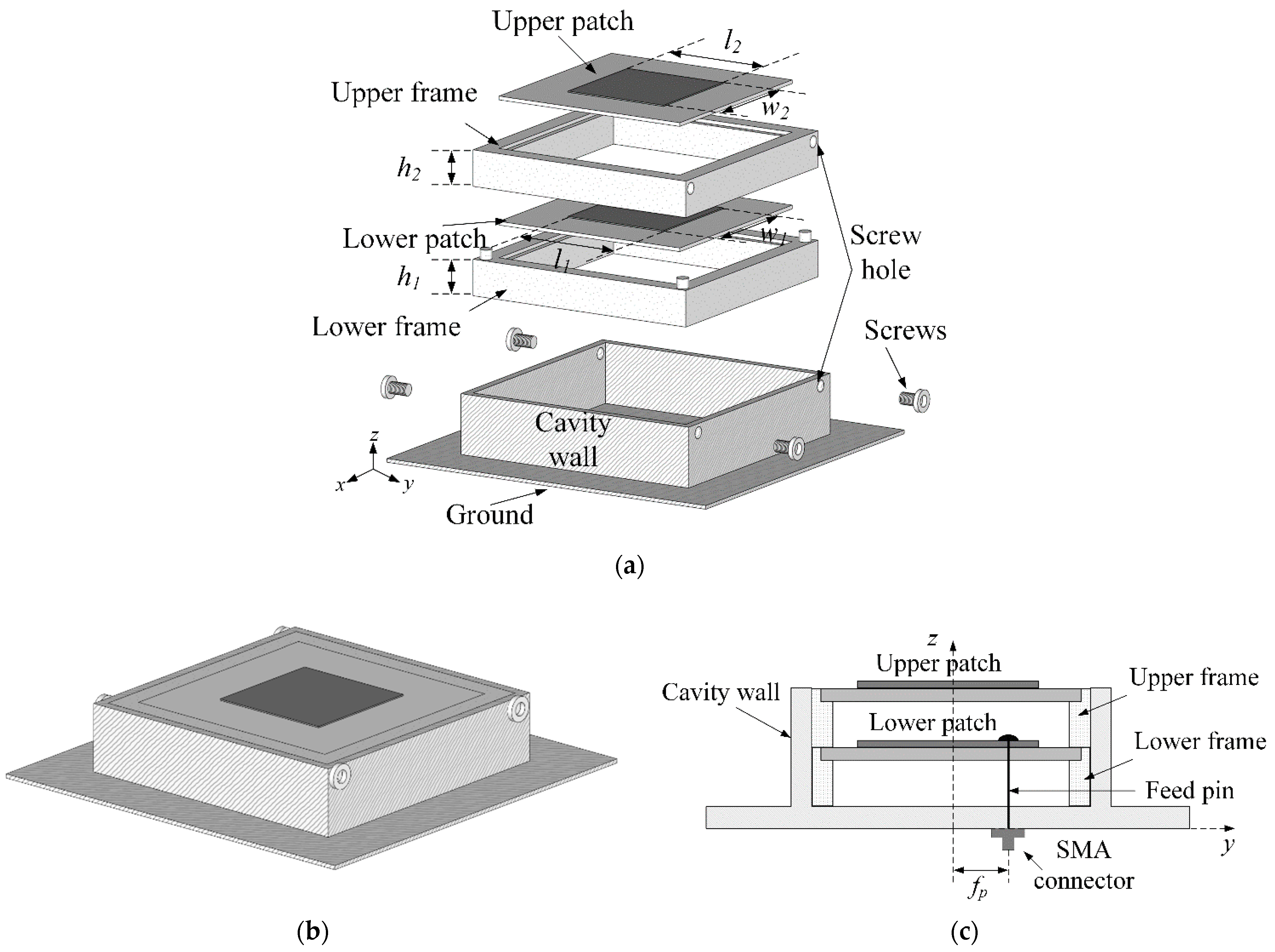
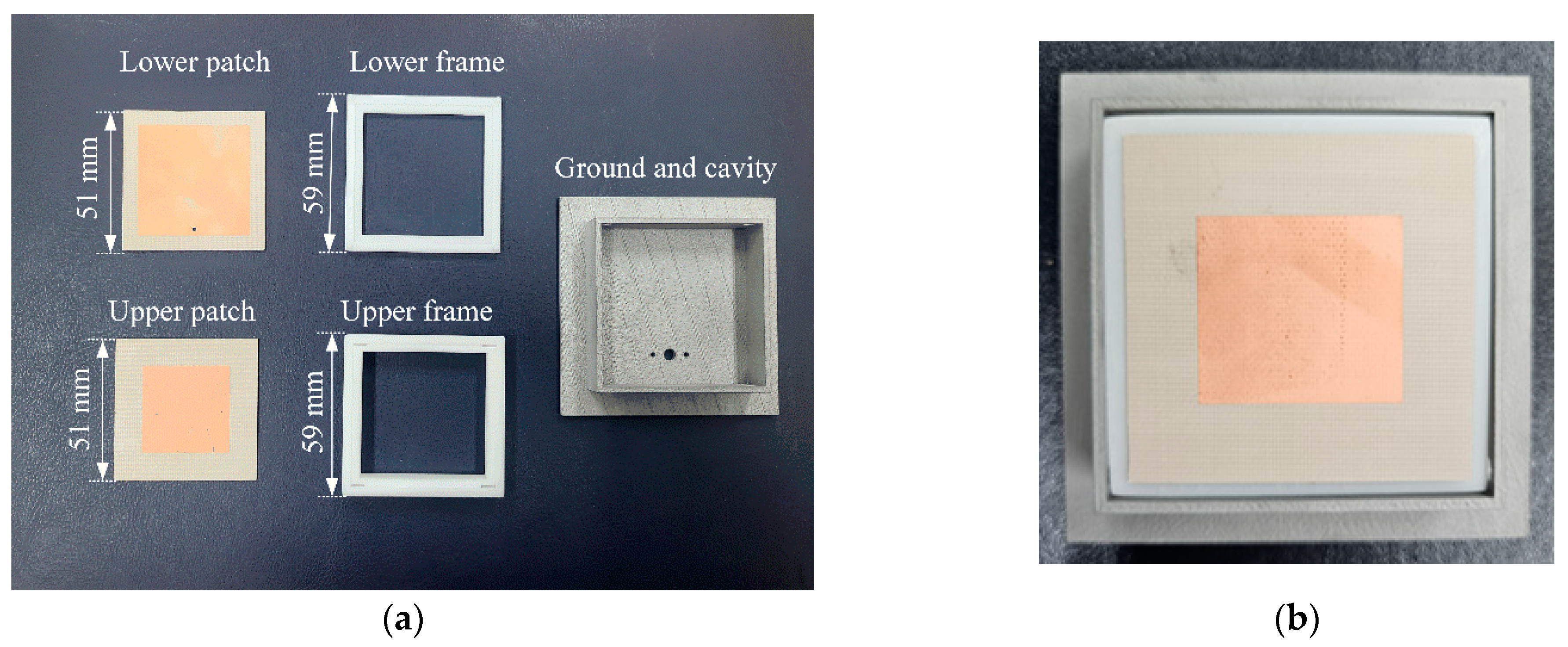
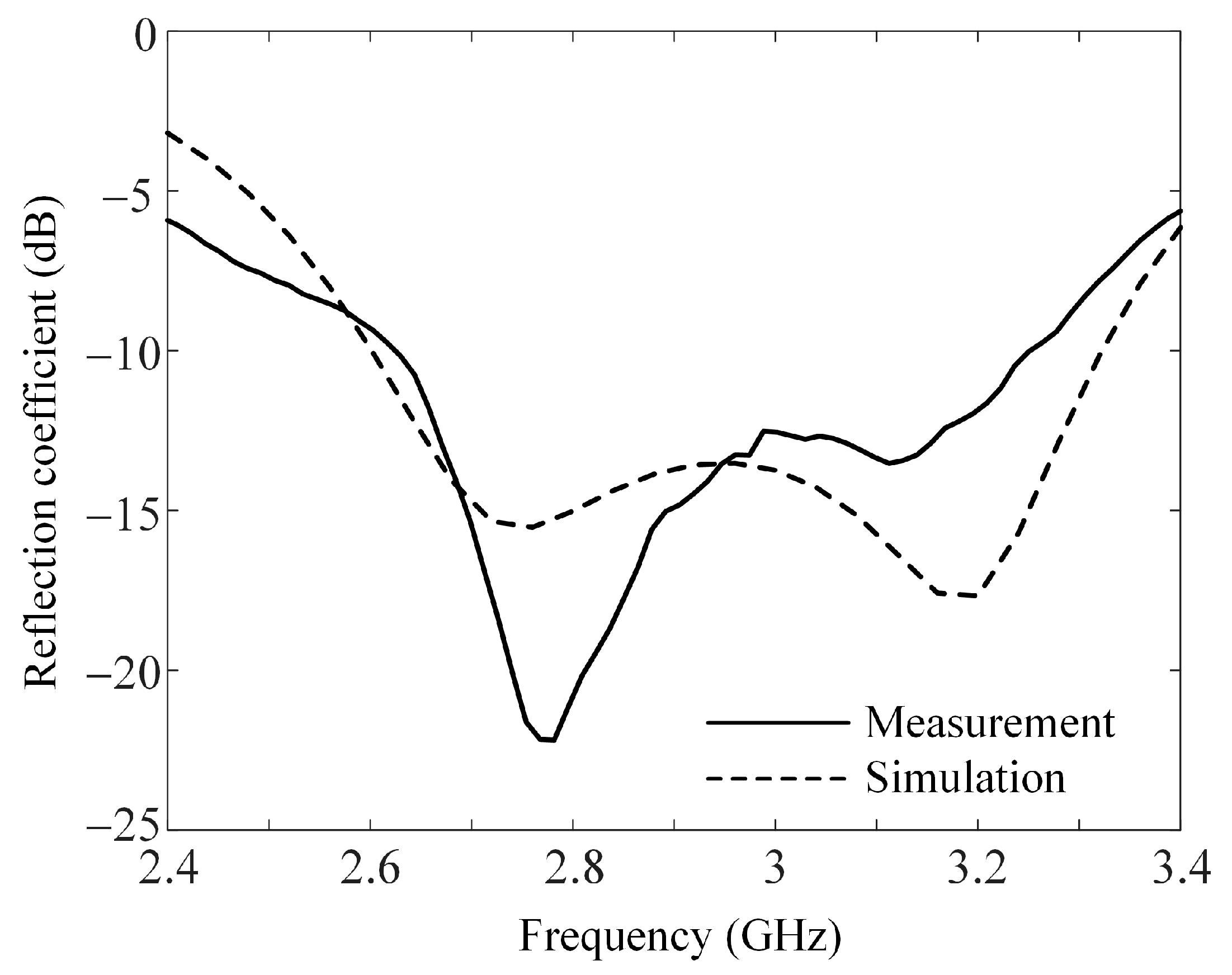
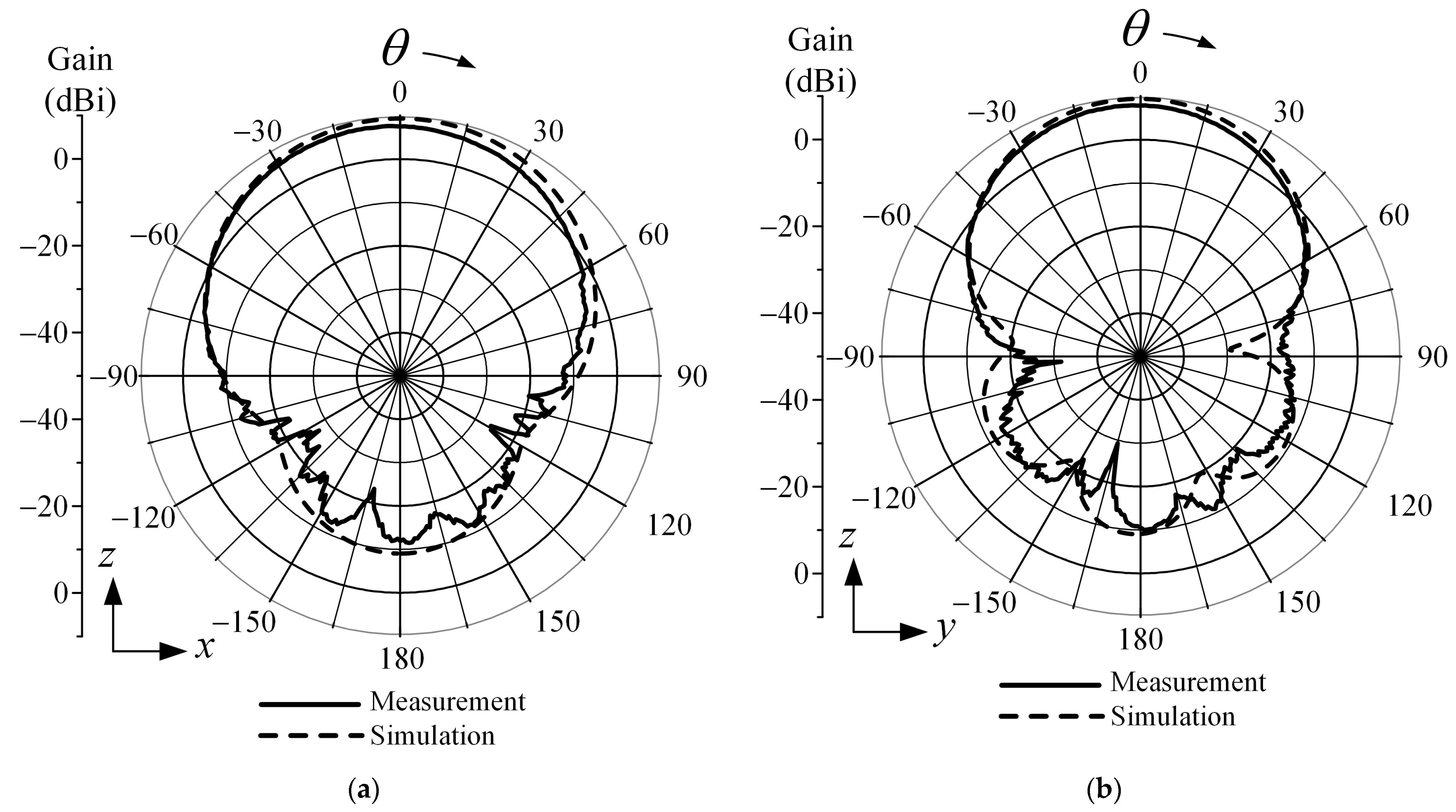
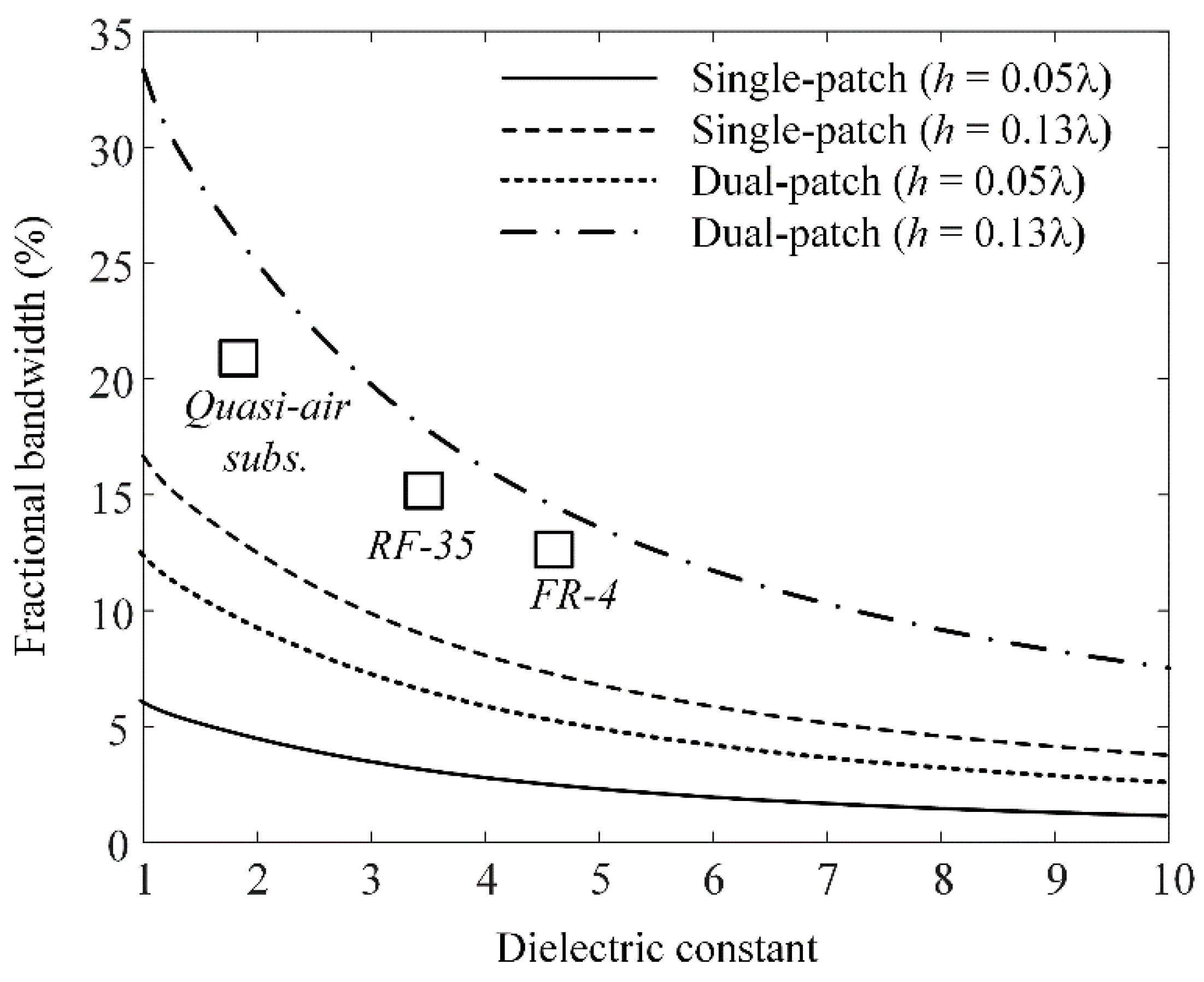
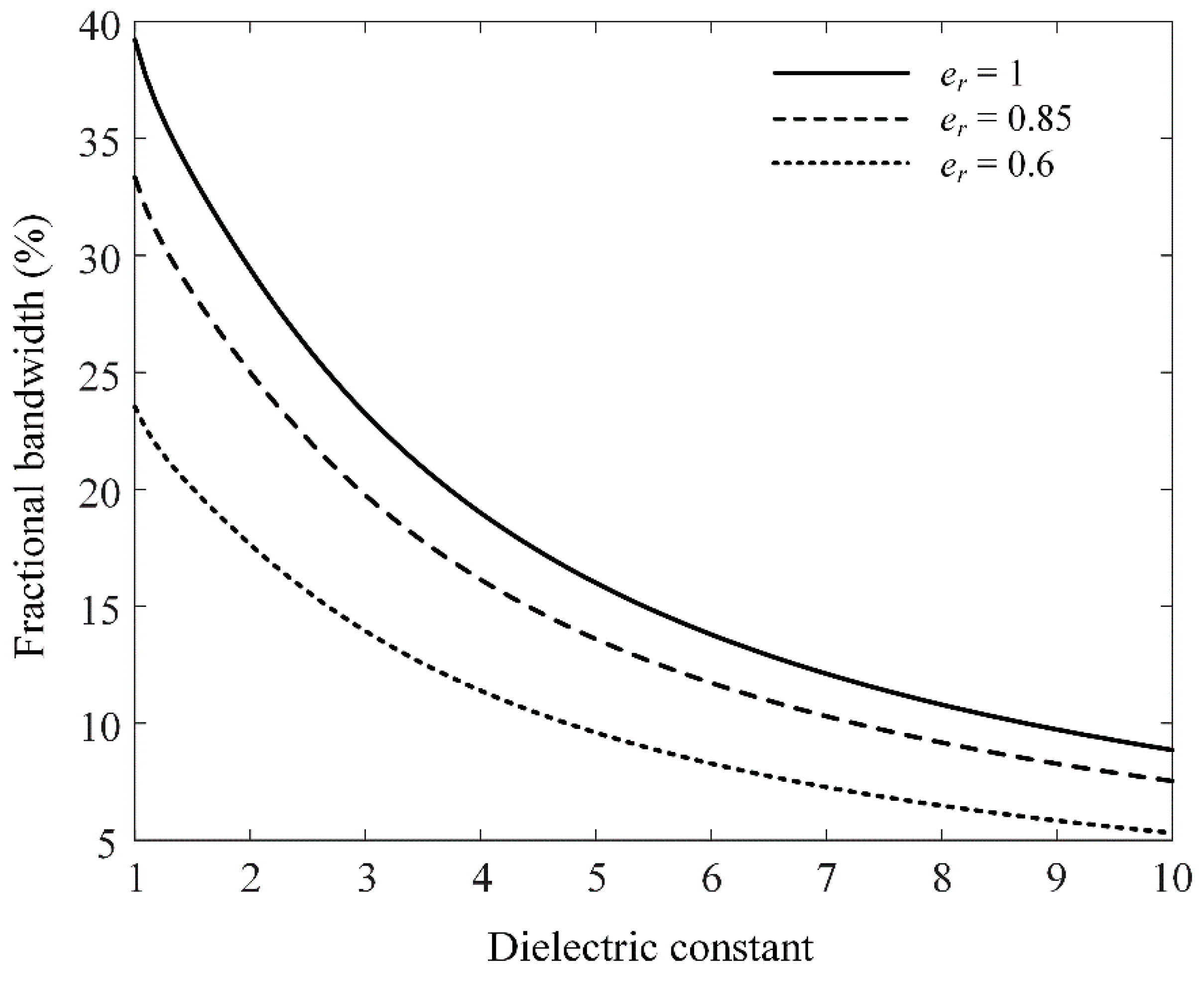

| Parameters | Value | Parameters | Value |
|---|---|---|---|
| w1 | 28.4 mm | w2 | 27 mm |
| l1 | 40.3 mm | l2 | 26.7 mm |
| h1 | 2.4 mm | h2 | 10.2 mm |
| fp | 19.3 mm |
Disclaimer/Publisher’s Note: The statements, opinions and data contained in all publications are solely those of the individual author(s) and contributor(s) and not of MDPI and/or the editor(s). MDPI and/or the editor(s) disclaim responsibility for any injury to people or property resulting from any ideas, methods, instructions or products referred to in the content. |
© 2024 by the authors. Licensee MDPI, Basel, Switzerland. This article is an open access article distributed under the terms and conditions of the Creative Commons Attribution (CC BY) license (https://creativecommons.org/licenses/by/4.0/).
Share and Cite
Jang, D.; Lee, J.-Y.; Choo, H. Design of a Stacked Dual-Patch Antenna with 3D Printed Thick Quasi-Air Substrates and a Cavity Wall for Wideband Applications. Appl. Sci. 2024, 14, 1571. https://doi.org/10.3390/app14041571
Jang D, Lee J-Y, Choo H. Design of a Stacked Dual-Patch Antenna with 3D Printed Thick Quasi-Air Substrates and a Cavity Wall for Wideband Applications. Applied Sciences. 2024; 14(4):1571. https://doi.org/10.3390/app14041571
Chicago/Turabian StyleJang, Doyoung, Jun-Yong Lee, and Hosung Choo. 2024. "Design of a Stacked Dual-Patch Antenna with 3D Printed Thick Quasi-Air Substrates and a Cavity Wall for Wideband Applications" Applied Sciences 14, no. 4: 1571. https://doi.org/10.3390/app14041571





